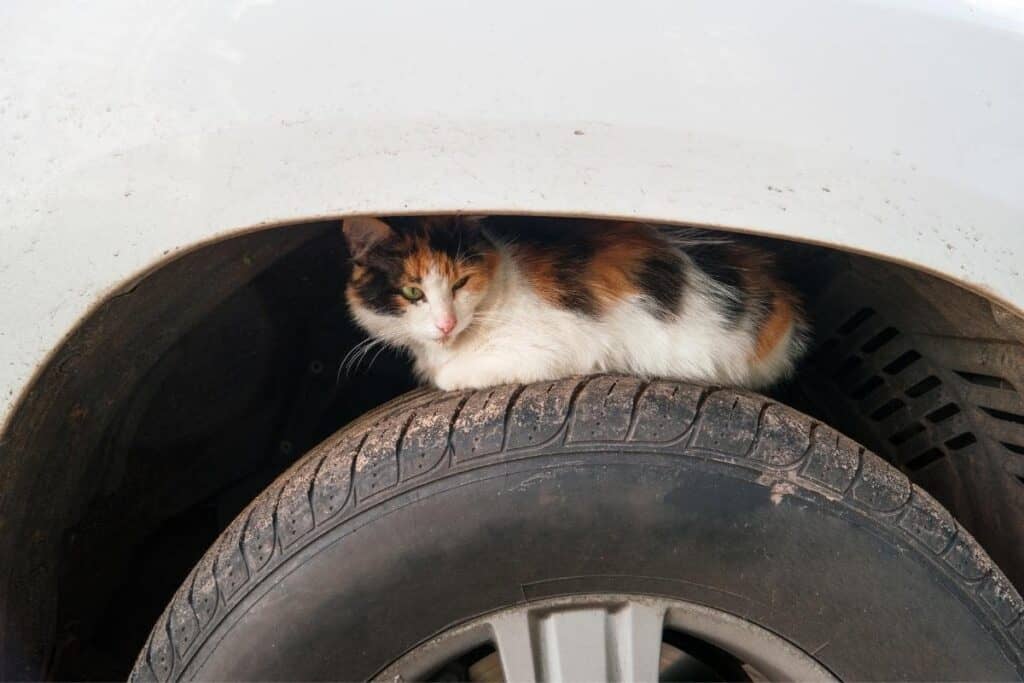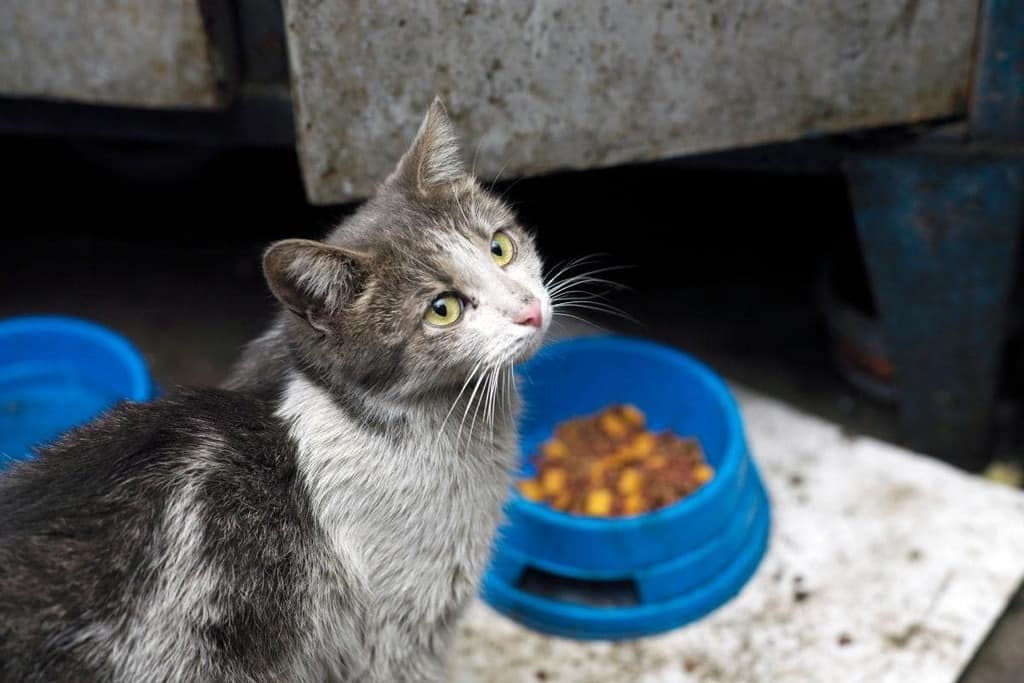Have you ever heard a meow outside your house and been confronted with an unfamiliar furball? If they seem desperate for attention, you might start to wonder – is this a stray cat or someone’s pet? This can soon snowball into a whole world of worries – are they being cared for? Is it safe to let them into my home? Should I feed them, if they are a stray cat? Where can I go for help?
But we’ve got you covered!
We know how it feels when you’re anxious about an animal, after trying to help several strays on our travels with Yoda (our own furry beast). In that time, we’ve managed to pick up lots of tips and tricks for sussing out what will best help your noisy visitor.
To help you safely look after any unexpected furry guests, this guide covers the basics of feeding and caring for neighborhood & stray cats. Including:
- Telling the difference between a stray cat vs a house cat
- Why and how to feed a stray cat
- Where to take an injured stray cat
- How to locate a lost cat’s owners
- What to do when a neighborhood cat won’t leave
Plus, we’ll dive into the politics of neighborhood cats cruising for meals, and how to stop your own cat from going to neighbors for seconds!
How to Help Feral and Stray Cats

Telling the Difference Between a Stray Cat or Someone’s Pet
When you are worried about a kitty in your yard or on your travels, this question may be the first that springs to mind. But telling the difference between a stray cat vs a pet cat can be a real puzzle!
Here’s a few ways to help you spot the difference:
- A wandering pet cat will usually:
- Have some form of ID, like a collar and tag or microchip
- Have a clean, well kept coat
- Be an average weight
- Have softer paw pads (from being indoors more often)
- Be friendly and approachable, and meow as a greeting
- Seem confident in their environment
- Move around during the day
- Not persist in seeking contact and move on after a while
- AT stray cat will usually:
- Have a messy or overly dirty coat
- No visible ID and no microchip, or a very dirty/old looking collar
- Be slightly underweight – as they may only be fed scraps by humans
- Have calloused or rough paw pads (from being outdoors)
- Be hesitant or wary, or seem to be begging loudly
- Seem unsure in their environment, as they could be lost
- Be present in quieter hours such as dawn and dusk
- Be persistent in seeking attention and food
It’s important to mention that there is a third type of cat you might encounter here: Feral Cats.
Feral cats are wild, and have been born and raised without human interaction. Even if they end up sneaking into your garage or outbuilding for warmth, they are in no way tame!
How to Spot a Feral Cat?
You will notice that they:
- Skinny, but typically a healthy weight – as they are used to hunting for themselves
- Have a relatively well-kept coat – as they have grown up learning to groom themselves
- Will tend to be very skittish and avoid humans – generally sticking to less populated areas, so they are unlikely to be begging at your door
- Have very rough and calloused paw pads – if you can get close enough to check!
Here’s a handy diagnostic table to help you:
| outdoor pet | stray cat | FeralCat | |
| Healthy Weight | ✔️ | X | ✔️/X |
| Good Coat Condition | ✔️ | X | ✔️/X |
| approachable | ✔️ | ✔️/X | X |
| Prone to Begging | X | ✔️ | X |
| Wandering in Daytime | ✔️ | X | X |
| Wandering at Night or Dawn | X | ✔️ | ✔️ |
| ID | ✔️ | X | X |
Top tip: become a kitty detective
The information above is just a general guideline; they are the typical qualities most people find true of the different types of outdoor cat.
But if you are worried about a particular kitty, my number one tip is to spend some time observing them.
All cats can be wary of people at times, so sitting a way off and watching their behavior and condition over time can give you those all important clues!
Doing this before you even try to approach the cat can help you to get a true sense of where your furry visitor fits into the above table. In fact, they may just run away when you try to get close!
Once you’re pretty sure that you have determined the new arrival’s situation, here’s how to handle them.
How to Help Stray Cats

Whether a stray cat has been abandoned or lost – there are ways you can help. But it’s super important to be cautious and careful, to make sure we don’t accidentally scare or cause further suffering to a stray. So take things slow and steady!
- Check for injuries and seek medical care if needed
- Give them fresh food and water
- Provide strays with an outdoor shelter
- Spread the word to help get them adopted out
If they seem healthy and mobile, approaching your fluffy visitor might be off the cards until they trust you enough to make contact. However, if they are injured, they may need more immediate help.
1. Where to Take an Injured Stray or Feral Cat?
If there is something visibly wrong with the kitty, it’s best to try to trap them with food, either using a live animal humane trap or by building a DIY version.
The Feral Friends Network can help you find veterinarians who are stray friendly and offer low-cost help.
Remember that trapping is super stressful for our furry friends, so should only be done when it’s totally necessary.
2. Feeding Stray Cats
Is it ok to feed stray cats? fa stray cat does not seem sick, then your first and biggest priority is food and water.
Read More: Ultimate Guide to Cat Nutrition
Is It Bad to Feed Stray Cats? Not at All!
Many stray cats choose to come to human homes and find the food and care they need. Yet take note: it’s vital to feed a stray cat the right thingor you could end up making them sick – which nobody would wish for!
Quality cat food is one of the best things to feed a stray. Feed strays in small quantities at first (3-4 times a day), before gradually building their portions to 2 larger meals a day.
If you aren’t the cat owner yourself, and you don’t want to risk a run to the store, here are some ideas for what to feed stray cats without cat food.
If You Feed a Stray Cat Will It Come Back?
Most likely, yep! This means you could begin to build trust and work towards being able to get them to a vet.
3. Providing Shelter for Strays
Assuming you are unable to handle the stray cat, your next priority is to help give the cat some shelter. You can use any boxes you have around the house, and follow a tutorial to create a cozy, warm, and dry place for your stray.
The key is to make an entranceway that’s large enough for the cat to enter, but small enough to keep in the warmth. Add straw, blankets or something similar inside for extra insulation for your furry friend. If it’s winter, here’s how to keep cats warm.
Elevating your shelter is also going to entice the stray inside. So either placing it on your porch, on a bench, or on some stones is a good idea.
4. Spreading the Word
While you build trust with your stray, start to spread the word to find it’s possible owners.
- Ask around your neighborhood, and try putting up flyers
- Check local newspapers and listings for “lost pet” adverts
- Post a photo and description on your social media
- Contact sites like PetsLocated and see if you have a match for any missing moggies
- Call local shelters to see if anyone has reported a missing kitty
- Ask a local vet to check if the cat is microchipped

What Next?
If the cat has no identification and no owners come forward after a few weeks, you have a few options.
- Adopt the stray cat into your home – give them the affection, attention and care they so desperately need. Just be sure to give them a full medical check first.
- Adopt them as an outdoor cat – with a shelter in place, you can look after the cat without having them in your home. Simply feed the cat at regular intervals, and be aware of any medical help they may need.
- Take them to a shelter – if you really aren’t able to care for your furry guest, then taking them to a shelter could help them to get adopted. However, you might want to first find out information about the euthanasia policy of your local shelter, as this could obviously affect your decision.
- TNR- if you feel unable to bring a stray into your life, that’s ok! Not everyone can provide the right home for a kitty, but if you can try and follow the Trap, Neuter, Release Method. This way you will be making a positive impact on the stray’s life, and the overall cat community. On average, the TNR process costs about $50-$75 from start to finish.
How to Help a Feral Cat

For feral cats, you can help them by following the Trap, Neuter, Release Method we mentioned above.
This is because they are usually unneutered, the feral population can grow super quickly. A high population leads to more fighting over territory, which isn’t good for our furry feline friends.
If you want more help or advice on helping your local feral cats, you can contact the Feral Friends Network.
How to Handle Neighborhood Cats
Why does my neighbor’s cat always come to my house?
There could be a number of reasons why you are receiving regular visits from a neighborhood pet:
- Territory – as part of their patrol, your place might be on the watch list for a cat’s territory
- Comfort – some cats might find your garden irresistibly sunny, or find your porch the perfect vantage point
- social interaction – many cats are extremely social animals, meaning they may be looking for some extra cuddles or a special belly rub
- Worry- if a cat has had an unpleasant experience at home, they may be seeking somewhere as a quiet refuge
Should I Feed My Neighbor’s Cat?
Is your neighbor’s cat always meowing at your door? While they might be acting like they’re starving, if you know your feline visitor really is someone’s pet it’s wise not to feed them.
- Overfeeding can lead to obesitywhich obviously isn’t good for a kitty’s long term health
- The pet may have medical conditionslike diabetes or thyroid issues, which means they need to be fed at certain times
- They may have an allergy or nutritional condition you are unaware of
If they aren’t bothering you, or your own pets, then absolutely give them a little scratch. New fur friends are great after all!
Lastly, try to find out who the owners are and pay them a visit.
Let them know their furball makes regular visits and get guidance from them on what they are comfortable with. This will give both you and the original owners real peace of mind.
How to Stop My Cat From Going to Neighbors?
If you are worried about your cat visiting other houses for any reason, or that someone might think they are a stray, here are some top tips to prevent your cat from roaming:
- ID- be sure your cat has a clear identification tag, to deter anyone from thinking they really are starving…despite how convincing their acting is!
- Feeding- ensure your cat is well-fed, so they aren’t actively seeking out other food sources
- Play- make sure your cat has lots of attention and playtime, so they are tired out and less likely to wander for miles
- Spay/Neuter – delayed de-sexing can be a big driver for cats to go out wandering. So neutering is a huge priority for owners and the safety of their pets
- Calm environment – make sure there’s nothing around the home that could be stressing out your cat and causing them to seek quiet elsewhere
- Consider keeping your cat indoors – keeping cats indoors can be better for their health, better for the environment, and prevent them from getting lost. Plus there’s a whole heap of other benefits for your kitty, and we made a list of the top 10 reasons to think about keeping them in.
We hope this guide to feeding and caring for stray, feral and neighborhood cats comes in handy next time you have a furry visitor at your doorstep!
If you have any neighborhood kitties you feed, or other tips on being an upstanding member of the feline community, do let us know! We’d love to hear your wonderful wisdom too!
SHARE THIS GUIDE TO HELPING STRAY CATS!
